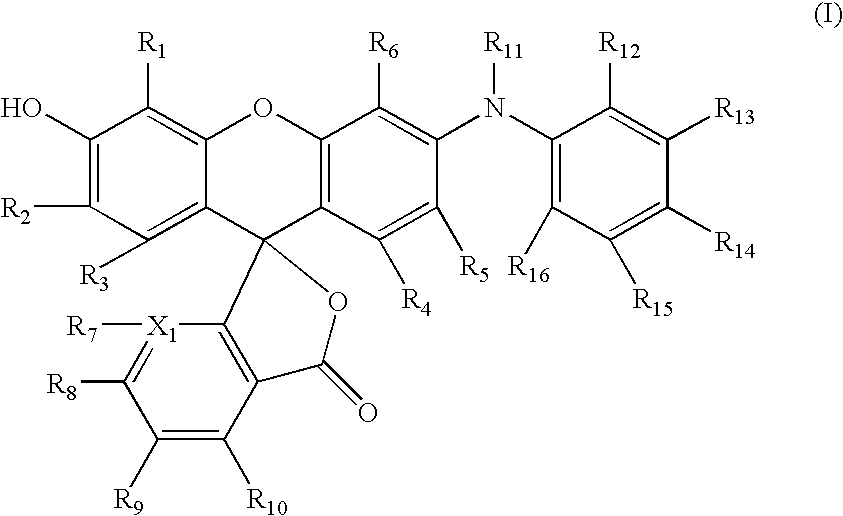Dyes
a dye and diaryl technology, applied in the field of compounds, can solve the problems of affecting etc., and achieve the effect of improving the quality of dyes
- Summary
- Abstract
- Description
- Claims
- Application Information
AI Technical Summary
Benefits of technology
Problems solved by technology
Method used
Image
Examples
example 1
Synthesis of Intermediates Used in the Synthesis of the Dyes.
Step 1A. Synthesis of 2-(5-bromo-2,4-dihydroxybenzoyl)benzoic acid
[0069]Aluminum chloride (8.48 g, 64 mmol) was added to a stirred suspension of phthalic anhydride (2.36 g, 16 mmol) in tetrachloroethane (40 mL) under nitrogen. Nitromethane (6 mL) was added to dissolve the reactants. 4-Bromoresorcinol (3 g, 16 mmol) was added and the mixture continued to be stirred under nitrogen. The reaction was monitored by high performance liquid chromatography (HPLC) over a period of 2 hours. It was observed that the reaction had ceased within the first 30 minutes, with starting materials remaining.
[0070]The solution was diluted with ethyl acetate (150 mL) and washed with 1M hydrochloric acid (2×100 mL). The product was extracted from the organic layer into a saturated solution of sodium bicarbonate in water (200 mL). The basic aqueous phase was acidified with 3M hydrochloric acid to a pH of 5. The product was extracted from the aqueou...
example ii
Synthesis of Compound I
[0086]2-(5-Bromo-2,4-dihydroxybenzoyl)benzoic acid (3.08 g, 9.14 mmol) and 3-hydroxydiphenylamine (1.69 g, 9.14 mmol) were dissolved in acetic acid (25 mL) and methane sulfonic acid (1.8 mL, 27.4 mmol) in a 100 mL flask. The reaction was heated at 100° for 7 hours. The reaction was allowed to cool to ambient temperature and remain overnight. The product crystallized from the reaction mixture. The product was collected, washed with acetic acid and acetone and vacuum dried to afford the desired dye as a dark red powder. (3.45 g, 6.95 mmol, 76% yield). The structure was confirmed by NMR and mass spectroscopy. HPLC analysis showed 96 Area % at 254 nm.
example iii
Synthesis of Compound II
[0087]N-Dodecyl-3-hydroxydiphenylamine (5.16 g, 0.014 mol), bromoketoacid (4.93 g, 0.014 mol), trifluoroacetic acid (25 mL) and trifluoroacetic anhydride (2.5 mL) were placed into a 100 mL pressure bottle. The mixture was heated with magnetic stirring at 110° C. for 7 hours. The reaction mixture was poured into ice-water (400 mL). The dark magenta solid was collected by suction filtration and washed with water. The crude solid was dissolved in ethyl acetate (400 mL) and washed with 2N sodium hydroxide. The organic layer was dried over sodium sulfate and concentrated. Silica gel chromatography (methanol / methylene chloride) afforded the dye as a red solid (4.1 g, 0.0063 mol, 45% yield).
PUM
| Property | Measurement | Unit |
|---|---|---|
| melting temperatures | aaaaa | aaaaa |
| melting temperatures | aaaaa | aaaaa |
| melting temperatures | aaaaa | aaaaa |
Abstract
Description
Claims
Application Information
 Login to View More
Login to View More - R&D
- Intellectual Property
- Life Sciences
- Materials
- Tech Scout
- Unparalleled Data Quality
- Higher Quality Content
- 60% Fewer Hallucinations
Browse by: Latest US Patents, China's latest patents, Technical Efficacy Thesaurus, Application Domain, Technology Topic, Popular Technical Reports.
© 2025 PatSnap. All rights reserved.Legal|Privacy policy|Modern Slavery Act Transparency Statement|Sitemap|About US| Contact US: help@patsnap.com


